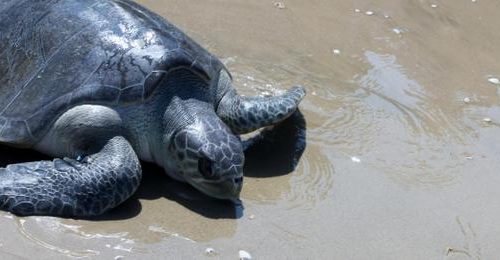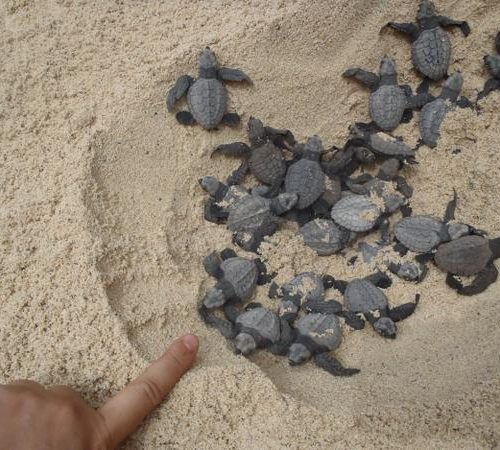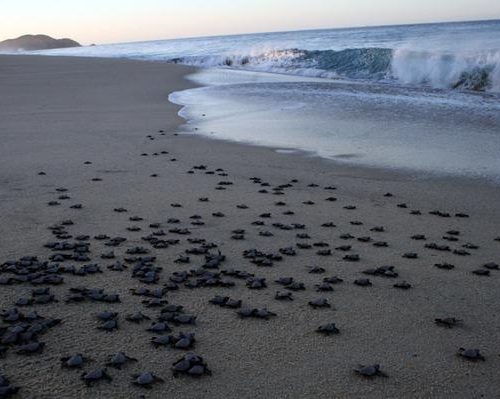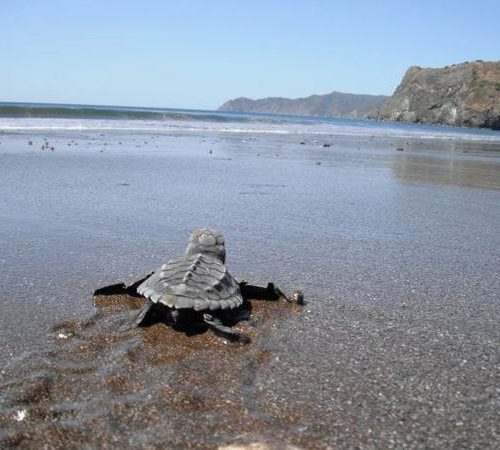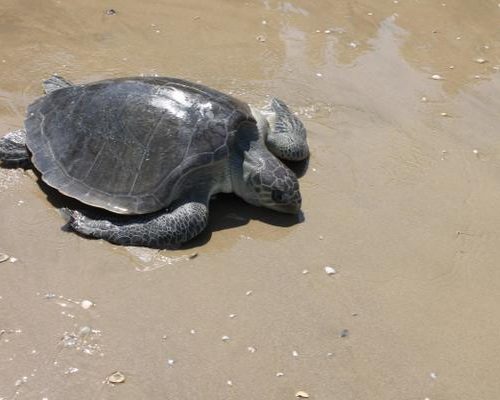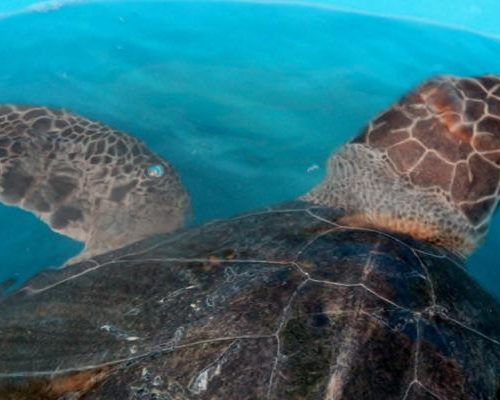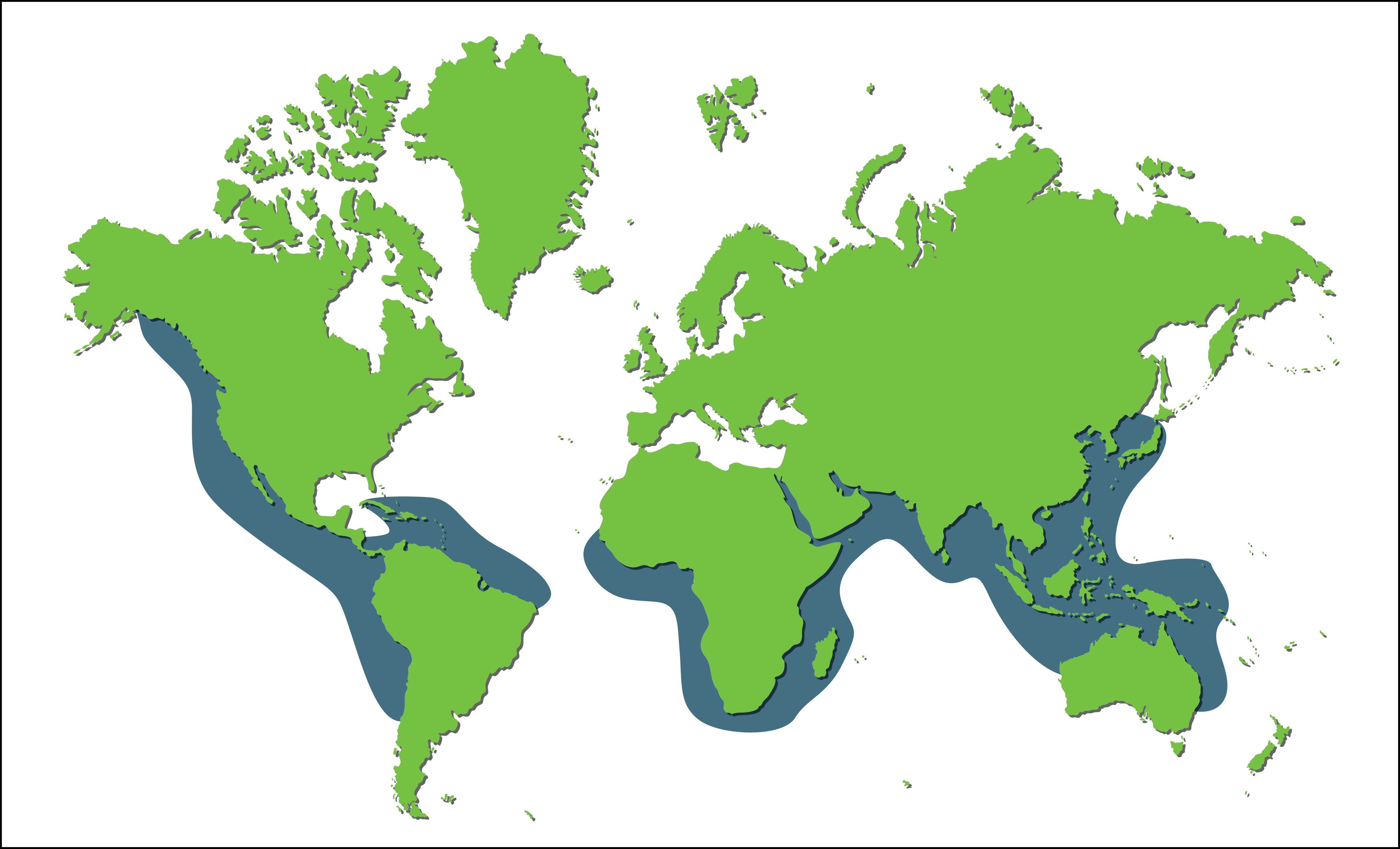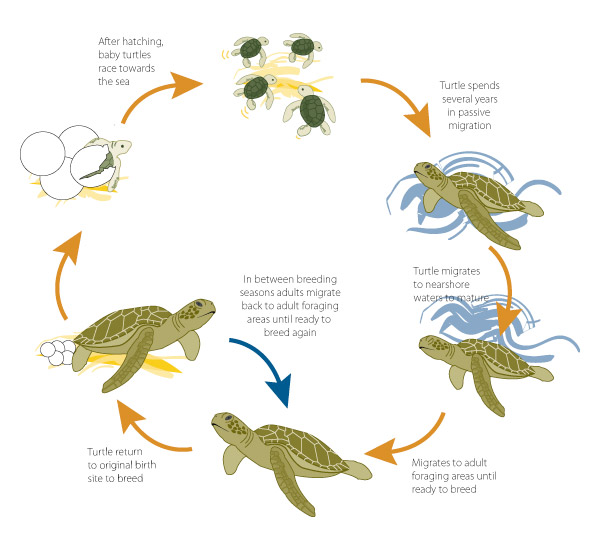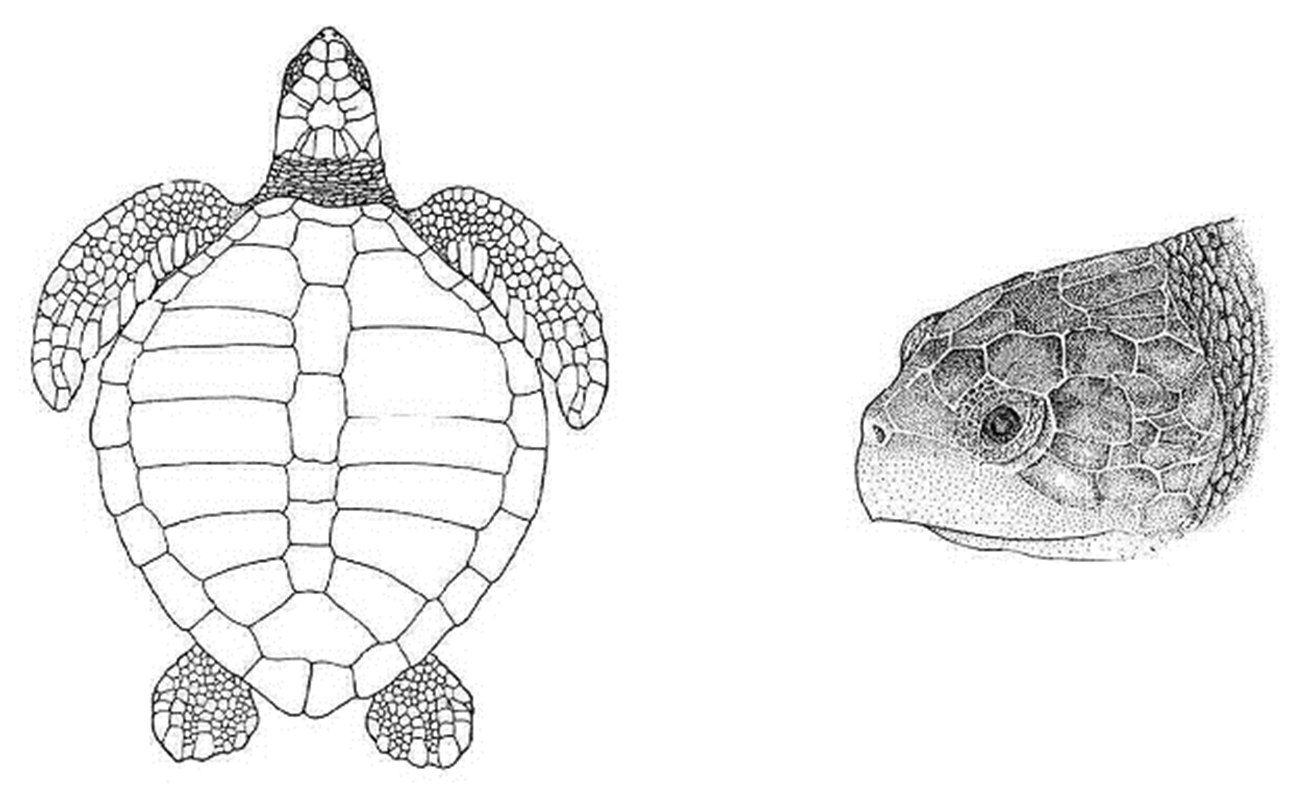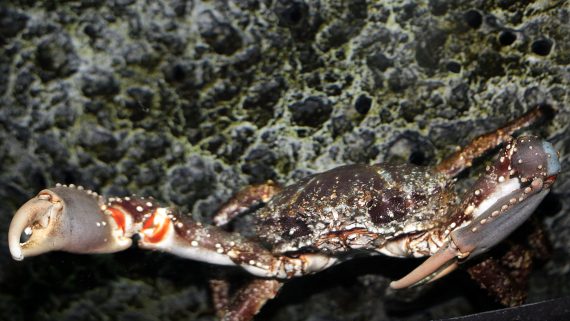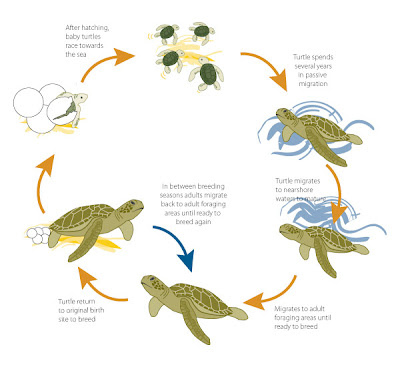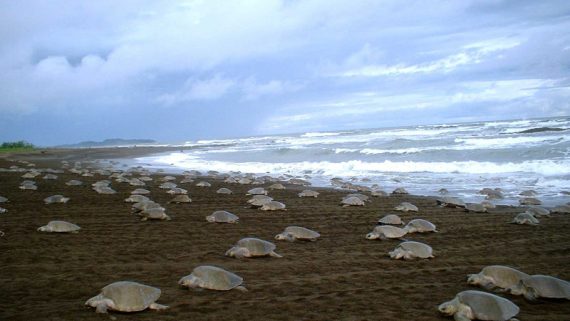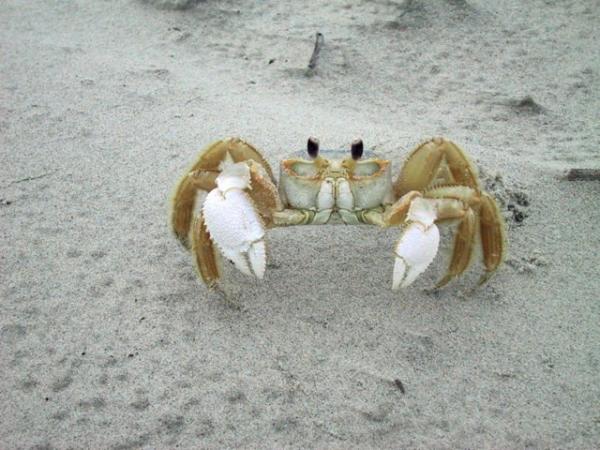Olive Ridley Sea Turtle (Lepidochelys olivacea)
Click here for more detailed information.
Scientific Classification
Class: Reptilia
Order: Testuidae
Family: Cheloniidae
Genus: Lepidochelys
Species: olivacea
Species Description
Small sea turtle species
Carapace: Olive colored; Heart shaped
Typical Adult:
Weight: 100 lb (45 kg)
Length: 21-31 in (55-80 cm)


Natural History
Range
Tropical regions of the south Atlantic, Pacific and Indian Oceans
Habitat
Open ocean
Shallow coastal waters
Open sandy beaches
Diet
Omnivore: algae, lobster crabs, tunicates, mollusks, shrimp and fish

Life History
Reproduction - Seasonal
Sexual maturity: approximately 15 years
Average clutch size: 100 eggs
Average clutches per season: 2
Range of nest incubation: 60-75 days
Lifespan
Unknown

- Recent genetic studies indicate that the genus of ridley turtles (Lepidochelys) split into two species, olive ridleys and Kemp’s ridleys, after the closing of the Isthmus of Panama.
- Both species of ridley turtles rock from side to side to compact the sand over a nest to disguise it.
- 1997’s Hurricane Pauline destroyed nearly half a million nests, the equivalent of 40 million eggs and 10 million hatchlings, on La Escobilla beach in the state of Oaxaca, Mexico.
Description
The adult olive ridley is relatively small. It can weigh up to 100 lbs and be as long as 30 inches. Its carapace is olive colored and heart shaped. This species varies somewhat in color, size and shape from region to region. The largest animals occur on the Pacific coast of Mexico. Each flipper has one or two claws.
Distribution
Olive ridleys can be found in the tropical regions of the south Atlantic, Pacific and Indian Oceans. In the south Atlantic they can be found along the coasts of west Africa and South America. In the eastern Pacific they occur from southern California to northern Chile. Adult olive ridleys often migrate long distances between feeding and breeding grounds. Although nesting occurs in 40 different countries, arribadas occur only on a few beaches in the eastern Pacific and northern Indian oceans.
Habitat
Olive ridleys occupy different habitats depending on their age. They mature, feed and nest in very different areas.
They spend the first few years in the open ocean. Here they associate with floating mats of sargassum seaweed. As juveniles they move within 10 mi (15 km) of shore using the shallower waters for feeding. Adult females use sandy beaches for nesting.
Diet
The Olive ridley eats a wide variety of food items. They eat algae, lobster, crabs, mollusks, shrimp, soft fleshy marine invertebrates and fish. They often dive to depths of 500 feet to forage on invertebrates.
Life History
With many reptiles, size is a more reliable indicator of sexual maturity than age. This is the case with sea turtles. Olive ridleys reach sexual maturity at about 15 years of age. When ready to breed, both males and females travel from feeding grounds to breeding areas just off shore of nesting beaching. Females return to the beach on which they were born to nest.
The olive ridley, like the Kemp’s ridley, has one of the most unusual nesting habits in the natural world. They exhibit mass synchronized nesting known as ‘arribadas‘ (Spanish for ‘mass arrivals’). Large groups of turtles gather off shore of nesting beaches. Then, all at once (usually at night), large numbers of female turtles come ashore and nest. Females dig nests with their rear flippers that are 12-22 in (30-55 cm) deep. They deposit their eggs into the nest, cover the nest with sand and return to the sea. Female olive ridleys nest every year. They produce one or two clutches of 100 eggs each season.
Incubation takes approximately 60 days. Like most reptiles, the temperature at which an egg is incubated determines its sex. This is referred to as temperature dependent sex determination, or TSD.
It may take several days for a hatchling to emerge from the nest. They usually emerge at night. Once on the surface, they quickly orient and move towards the ocean. They use moonlight and starlight reflected from the surface of the water as a guide. After entering the water, the hatchling swims for a long time. It is thought that they find beds/rafts of sargassum algae to float around with. It is there that they begin to eat and grow.
Threats
The olive ridley is the most abundant of the sea turtles. Still, it has experienced a 50% reduction in population size since the 1960’s. The principal causes of the decline is long-term harvesting of eggs and adults on nesting beaches and accidental capture in fishing gear.
Sea turtles face different predators as they age.
Eggs and hatchlings are the most vulnerable. They may be eaten by a wide range of coastal predators, such as crabs, large lizards, small mammals (e.g. raccoons, coatis, dogs, coyotes, genets, mongooses) and a variety of birds of prey and shorebirds.
Young sea turtles can be eaten by cephalopods, sharks and other large fish once they are in the ocean.
Adults face fewer serious predators, although large marine predators such as orcas and sharks occasionally attack and eat sea turtles.
Nesting females are also attacked or harassed by feral dogs, large predators, biting flies and humans.
Hunting. Historically, the principal cause of decline in the olive ridley sea turtle population was long-term harvest. Eggs and adult females were harvested on nesting beaches. Juveniles and adults were harvested on feeding grounds. Although this practice is much less common now, it still occurs in many areas around the world.
Commercial Fishing. Accidental capture in fishing gear is a serious ongoing cause of death that also negatively affects the population.
Pollution:
Trash. Turtles eat a wide array of the 24,000 metric tons of floating trash dumped in the ocean each year. This includes such items as bags, sheets, pellets, balloons and abandoned fishing line. Sea turtles may mistake the floating plastic for jellyfish, a common food item. When turtles eat plastic, it causes many health concerns, including blocked intestines, malnutrition, suffocation, ulcers and starvation. Ingested plastics also release toxins that accumulate in the turtles tissues. These toxins lead to thinner eggshells, tissue damage and unusual behavior.
Artificial lighting. Artificial light impacts nesting females and hatchlings. Females appear to prefer nesting on beaches free of artificial lighting or shadowed. Hatchlings automatically move towards the ocean using reflected moonlight or starlight on the water as a guide. Artificial light is brighter and can confuse them so they navigate inland towards that light and away from the ocean. This results in dehydration and predation. Artificial lighting causes tens of thousands of hatchling deaths per year.
Climate Change. Changes in global temperatures can affect the turtles in many ways.
- Since the sex of sea turtle hatchlings depends on the temperature at which the eggs were incubated, high sand temperatures may change sex ratios resulting in too few males to sustain the population.
- As water levels rise, a number of good nesting beaches will be lost.
- The areas where sea turtles feed may be dramatically altered by climate change.
Click here for more information on the impact of climate change on sea turtle populations.
Habitat Destruction. Habitat destruction and intrusion on the habitat by humans is a serious threat to sea turtles. Beach development for people deprives the turtles of good nesting areas, forcing them to leave or nest closer to the water.
Growth of cities often leads to the siltation of sandy beaches and the construction of docks and marinas can destroy near-shore habitats. Boat traffic and dredging damages habitat and can also injure or kill turtles when boats collide with turtles at or near the surface.
Our lack of knowledge about the population and life history of olive ridley sea turtles makes it very difficult to understand what this species needs to survive and thrive.
Conservation
All over the world the sea turtles continue to decline. Their conservation and recovery requires international cooperation in order to address all of the threats to these species.
In the U.S., the National Oceanic and Atmospheric Administration (NOAA) Fisheries and the U.S. Fish and Wildlife Service (USFWS) protect sea turtles. NOAA monitors the turtles while they are in the ocean and USFWS while they are on land. Federal and state agencies have developed regulations to eliminate or reduce threats to sea turtles. For example, NOAA works closely with the shrimp trawl fishing industry to develop turtle excluder devices (TEDs) and reduce the death of sea turtles accidentally caught in shrimp trawl gear. TEDs that are large enough to exclude even the largest sea turtles are now required in shrimp trawl nets. The USFWS, in partnership with other organizations, provides protection for sea turtles and their nests during the nesting season.
You can help too. In many places, workers and volunteers from many different organizations help protect the turtles during the nesting season. Volunteers help locate and protect nests, relocate nests threatened by disturbance or guide hatchlings to the ocean. Even after the eggs hatch, these volunteers can assist scientists as they uncover and count eggs and hatchlings left in the nest.
There are many other ways that we can help as well:
- Limit our use of plastics
- Refuse, Reduce, Reuse, Recycle (see Womble’s Tale)
- Use only turtle friendly products
- Respect sea turtles beaches and nests
- Support sea turtle research
- Volunteer with a recommended sea turtle conservation organization
- Support your local sea turtle conservation organizations
Ernst, C. H.; Lovich, J.E. (2009). Turtles of the United States and Canada (2 ed.). JHU Press. ISBN 978-0-8018-9121-2.
Janzen, Fredric J (1994). “Climate change and temperature-dependent sex determination in reptiles” (PDF). Population Biology 91 (16): 7487–7490.
Lorne, Jacquelyn; Michael Salmon (2007). “Effects of exposure to artificial lighting on orientation of hatchling sea turtles on the beach and in the ocean” (PDF). Endangered Species Research 3: 23. doi:10.3354/esr003023.
Spotila, James R. (2004). Sea Turtles: A Complete Guide to their Biology, Behavior, and Conservation. Baltimore, Maryland: Johns Hopkins University Press and Oakwood Arts. ISBN 0-8018-8007-6.
US Fish and WIldlife Service, North Florida Ecological Services, Olive Ridley Turtle Fact Sheet.
Witherington, Blair (2006). “Ancient Origins”. Sea Turtles – An Extraordinary Natural History of Some Uncommon Turtles. St Paul, Minnesota: MBI Publishing Company. ISBN 0-7603-2644-4.
Wynne, Kate; Schwartz, Malia (1999). Guide to Marine Mammals and Turtles of the U.S. Atlantic and Gulf of Mexico. illustrated by Garth Mix (2nd ed.). Rhode Island Sea Grant. ISBN 0-938412-43-4.


